Economic Principles and Decision Making Analysis for Energy Bars
VerifiedAdded on 2021/01/02
|12
|2327
|492
Report
AI Summary
This report provides an in-depth analysis of economic principles and decision-making processes, focusing on the introduction of the Schmeckt Besser energy bar by Schmeckt Gut. It explores the concept of elasticity, including price elasticity of demand and cross-elasticity of demand, to understand how changes in price affect demand and how the demand for Schmeckt Gut's product relates to its competitors. The report calculates total revenue at different price points and determines the price elasticity of demand. It also examines the market structure, specifically considering a monopolistic market, and offers recommendations to the Schmeckt Gut Research Department. The report emphasizes the importance of understanding market trends, customer demand, and the competitive landscape to ensure the successful launch of the energy bar. The analysis includes the calculation of elasticity, revenue, and an understanding of market dynamics to make informed decisions.
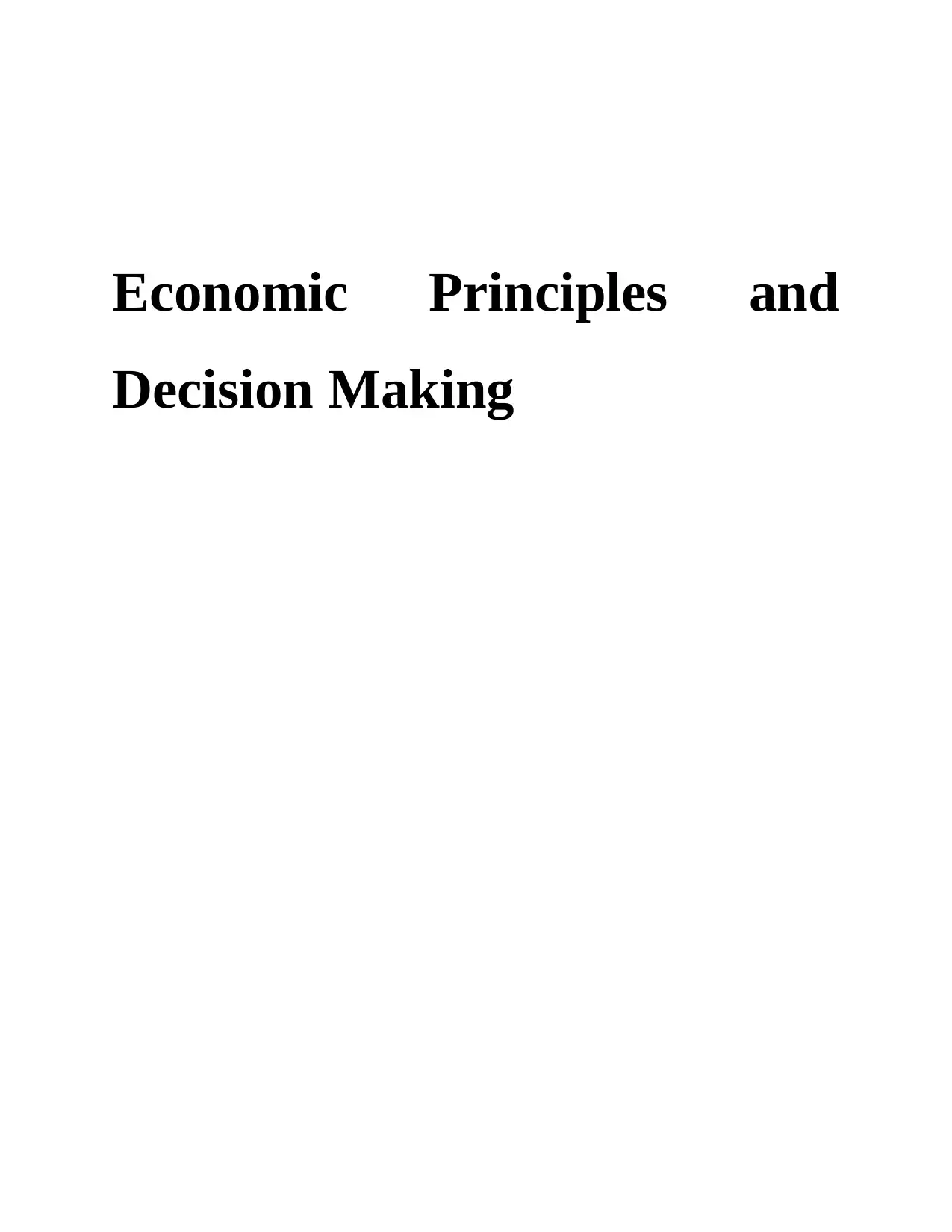
Economic Principles and
Decision Making
Decision Making
Paraphrase This Document
Need a fresh take? Get an instant paraphrase of this document with our AI Paraphraser
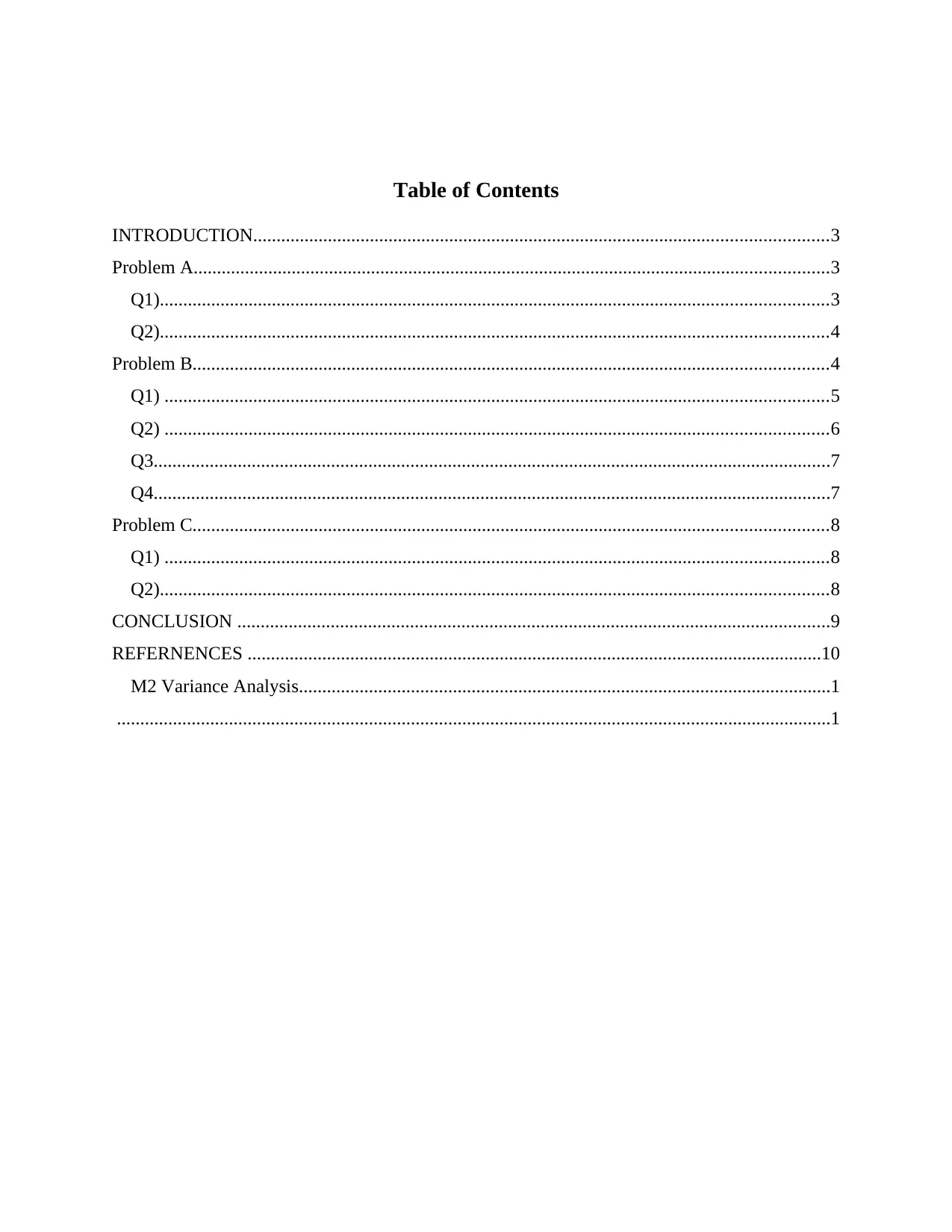
Table of Contents
INTRODUCTION...........................................................................................................................3
Problem A........................................................................................................................................3
Q1)...............................................................................................................................................3
Q2)...............................................................................................................................................4
Problem B........................................................................................................................................4
Q1) ..............................................................................................................................................5
Q2) ..............................................................................................................................................6
Q3.................................................................................................................................................7
Q4.................................................................................................................................................7
Problem C........................................................................................................................................8
Q1) ..............................................................................................................................................8
Q2)...............................................................................................................................................8
CONCLUSION ...............................................................................................................................9
REFERNENCES ...........................................................................................................................10
M2 Variance Analysis..................................................................................................................1
.........................................................................................................................................................1
INTRODUCTION...........................................................................................................................3
Problem A........................................................................................................................................3
Q1)...............................................................................................................................................3
Q2)...............................................................................................................................................4
Problem B........................................................................................................................................4
Q1) ..............................................................................................................................................5
Q2) ..............................................................................................................................................6
Q3.................................................................................................................................................7
Q4.................................................................................................................................................7
Problem C........................................................................................................................................8
Q1) ..............................................................................................................................................8
Q2)...............................................................................................................................................8
CONCLUSION ...............................................................................................................................9
REFERNENCES ...........................................................................................................................10
M2 Variance Analysis..................................................................................................................1
.........................................................................................................................................................1
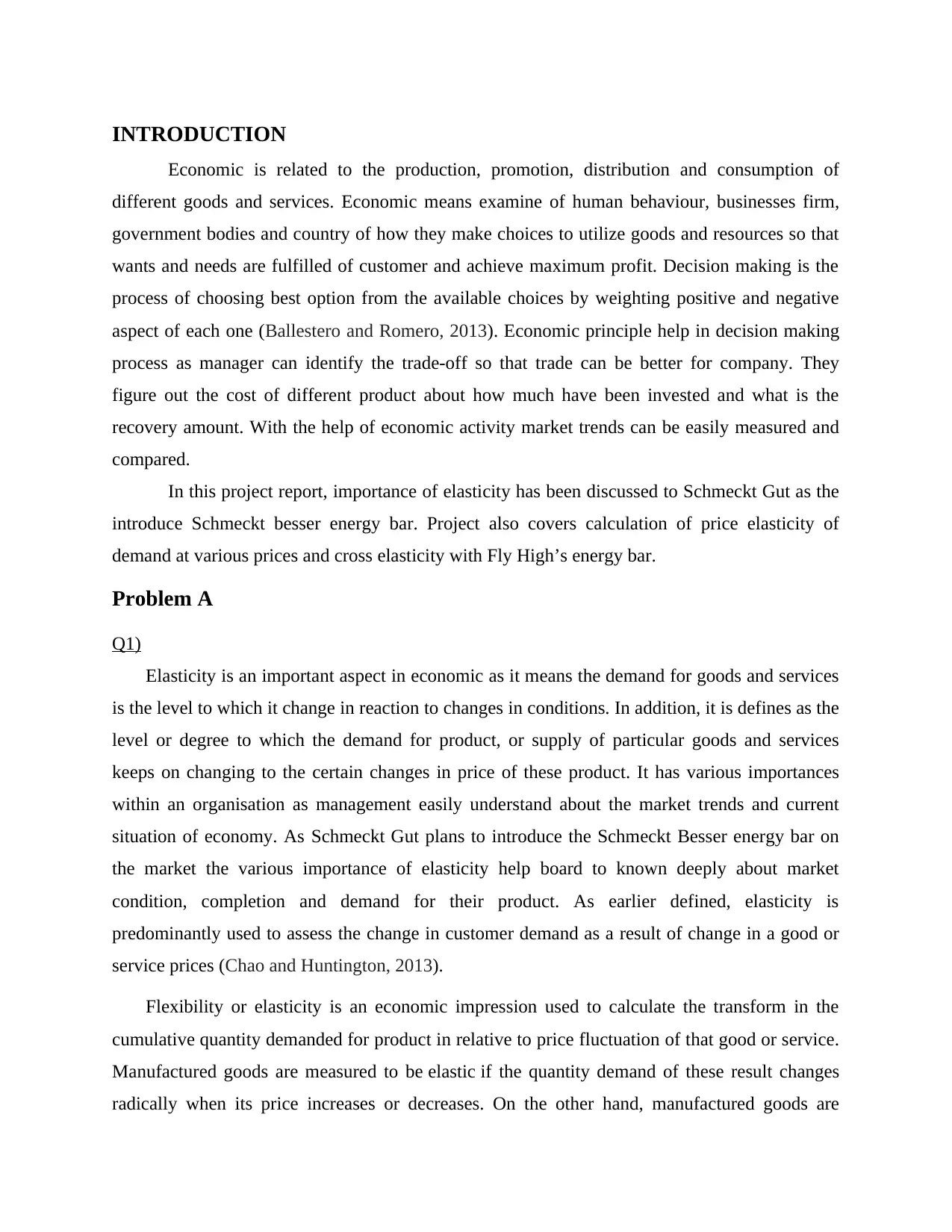
INTRODUCTION
Economic is related to the production, promotion, distribution and consumption of
different goods and services. Economic means examine of human behaviour, businesses firm,
government bodies and country of how they make choices to utilize goods and resources so that
wants and needs are fulfilled of customer and achieve maximum profit. Decision making is the
process of choosing best option from the available choices by weighting positive and negative
aspect of each one (Ballestero and Romero, 2013). Economic principle help in decision making
process as manager can identify the trade-off so that trade can be better for company. They
figure out the cost of different product about how much have been invested and what is the
recovery amount. With the help of economic activity market trends can be easily measured and
compared.
In this project report, importance of elasticity has been discussed to Schmeckt Gut as the
introduce Schmeckt besser energy bar. Project also covers calculation of price elasticity of
demand at various prices and cross elasticity with Fly High’s energy bar.
Problem A
Q1)
Elasticity is an important aspect in economic as it means the demand for goods and services
is the level to which it change in reaction to changes in conditions. In addition, it is defines as the
level or degree to which the demand for product, or supply of particular goods and services
keeps on changing to the certain changes in price of these product. It has various importances
within an organisation as management easily understand about the market trends and current
situation of economy. As Schmeckt Gut plans to introduce the Schmeckt Besser energy bar on
the market the various importance of elasticity help board to known deeply about market
condition, completion and demand for their product. As earlier defined, elasticity is
predominantly used to assess the change in customer demand as a result of change in a good or
service prices (Chao and Huntington, 2013).
Flexibility or elasticity is an economic impression used to calculate the transform in the
cumulative quantity demanded for product in relative to price fluctuation of that good or service.
Manufactured goods are measured to be elastic if the quantity demand of these result changes
radically when its price increases or decreases. On the other hand, manufactured goods are
Economic is related to the production, promotion, distribution and consumption of
different goods and services. Economic means examine of human behaviour, businesses firm,
government bodies and country of how they make choices to utilize goods and resources so that
wants and needs are fulfilled of customer and achieve maximum profit. Decision making is the
process of choosing best option from the available choices by weighting positive and negative
aspect of each one (Ballestero and Romero, 2013). Economic principle help in decision making
process as manager can identify the trade-off so that trade can be better for company. They
figure out the cost of different product about how much have been invested and what is the
recovery amount. With the help of economic activity market trends can be easily measured and
compared.
In this project report, importance of elasticity has been discussed to Schmeckt Gut as the
introduce Schmeckt besser energy bar. Project also covers calculation of price elasticity of
demand at various prices and cross elasticity with Fly High’s energy bar.
Problem A
Q1)
Elasticity is an important aspect in economic as it means the demand for goods and services
is the level to which it change in reaction to changes in conditions. In addition, it is defines as the
level or degree to which the demand for product, or supply of particular goods and services
keeps on changing to the certain changes in price of these product. It has various importances
within an organisation as management easily understand about the market trends and current
situation of economy. As Schmeckt Gut plans to introduce the Schmeckt Besser energy bar on
the market the various importance of elasticity help board to known deeply about market
condition, completion and demand for their product. As earlier defined, elasticity is
predominantly used to assess the change in customer demand as a result of change in a good or
service prices (Chao and Huntington, 2013).
Flexibility or elasticity is an economic impression used to calculate the transform in the
cumulative quantity demanded for product in relative to price fluctuation of that good or service.
Manufactured goods are measured to be elastic if the quantity demand of these result changes
radically when its price increases or decreases. On the other hand, manufactured goods are
⊘ This is a preview!⊘
Do you want full access?
Subscribe today to unlock all pages.

Trusted by 1+ million students worldwide
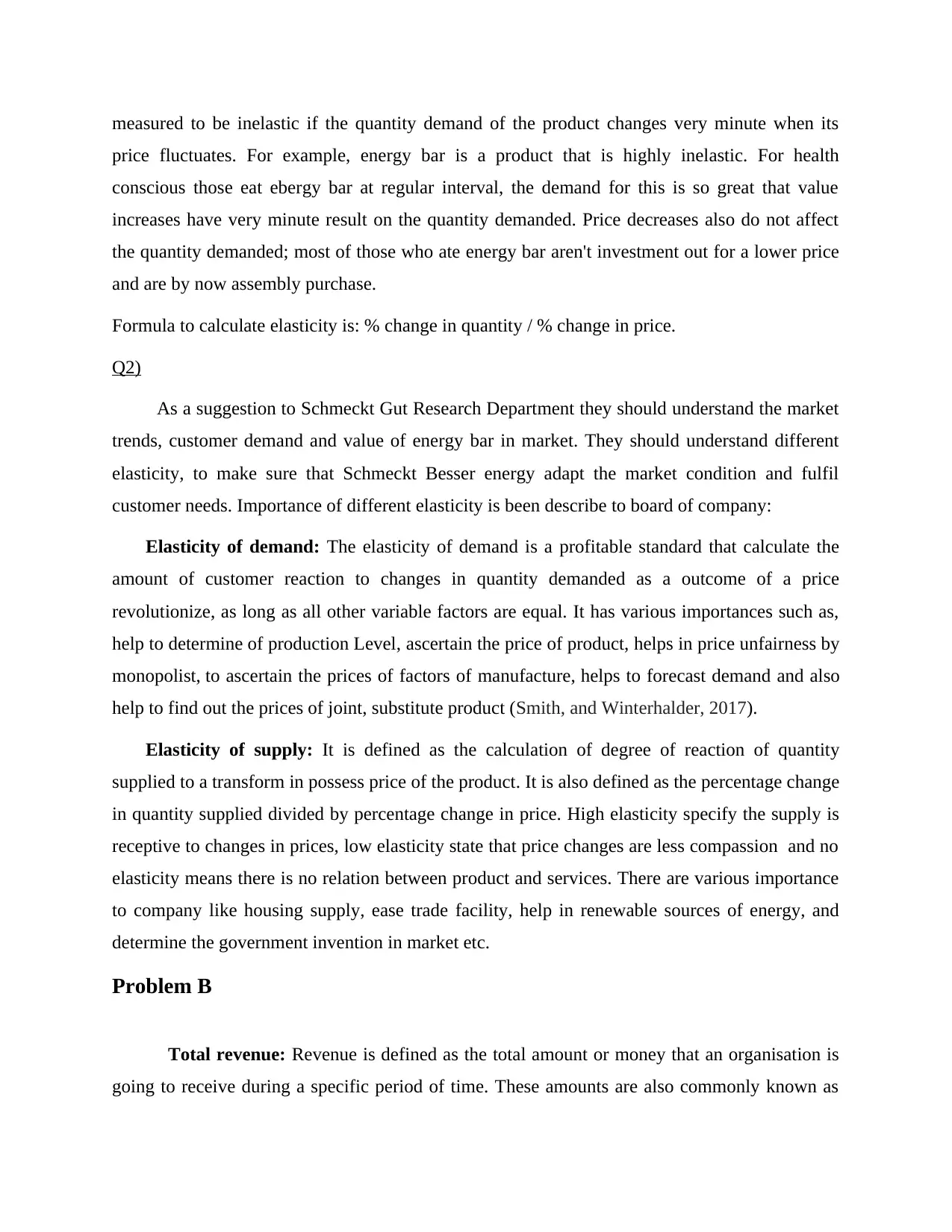
measured to be inelastic if the quantity demand of the product changes very minute when its
price fluctuates. For example, energy bar is a product that is highly inelastic. For health
conscious those eat ebergy bar at regular interval, the demand for this is so great that value
increases have very minute result on the quantity demanded. Price decreases also do not affect
the quantity demanded; most of those who ate energy bar aren't investment out for a lower price
and are by now assembly purchase.
Formula to calculate elasticity is: % change in quantity / % change in price.
Q2)
As a suggestion to Schmeckt Gut Research Department they should understand the market
trends, customer demand and value of energy bar in market. They should understand different
elasticity, to make sure that Schmeckt Besser energy adapt the market condition and fulfil
customer needs. Importance of different elasticity is been describe to board of company:
Elasticity of demand: The elasticity of demand is a profitable standard that calculate the
amount of customer reaction to changes in quantity demanded as a outcome of a price
revolutionize, as long as all other variable factors are equal. It has various importances such as,
help to determine of production Level, ascertain the price of product, helps in price unfairness by
monopolist, to ascertain the prices of factors of manufacture, helps to forecast demand and also
help to find out the prices of joint, substitute product (Smith, and Winterhalder, 2017).
Elasticity of supply: It is defined as the calculation of degree of reaction of quantity
supplied to a transform in possess price of the product. It is also defined as the percentage change
in quantity supplied divided by percentage change in price. High elasticity specify the supply is
receptive to changes in prices, low elasticity state that price changes are less compassion and no
elasticity means there is no relation between product and services. There are various importance
to company like housing supply, ease trade facility, help in renewable sources of energy, and
determine the government invention in market etc.
Problem B
Total revenue: Revenue is defined as the total amount or money that an organisation is
going to receive during a specific period of time. These amounts are also commonly known as
price fluctuates. For example, energy bar is a product that is highly inelastic. For health
conscious those eat ebergy bar at regular interval, the demand for this is so great that value
increases have very minute result on the quantity demanded. Price decreases also do not affect
the quantity demanded; most of those who ate energy bar aren't investment out for a lower price
and are by now assembly purchase.
Formula to calculate elasticity is: % change in quantity / % change in price.
Q2)
As a suggestion to Schmeckt Gut Research Department they should understand the market
trends, customer demand and value of energy bar in market. They should understand different
elasticity, to make sure that Schmeckt Besser energy adapt the market condition and fulfil
customer needs. Importance of different elasticity is been describe to board of company:
Elasticity of demand: The elasticity of demand is a profitable standard that calculate the
amount of customer reaction to changes in quantity demanded as a outcome of a price
revolutionize, as long as all other variable factors are equal. It has various importances such as,
help to determine of production Level, ascertain the price of product, helps in price unfairness by
monopolist, to ascertain the prices of factors of manufacture, helps to forecast demand and also
help to find out the prices of joint, substitute product (Smith, and Winterhalder, 2017).
Elasticity of supply: It is defined as the calculation of degree of reaction of quantity
supplied to a transform in possess price of the product. It is also defined as the percentage change
in quantity supplied divided by percentage change in price. High elasticity specify the supply is
receptive to changes in prices, low elasticity state that price changes are less compassion and no
elasticity means there is no relation between product and services. There are various importance
to company like housing supply, ease trade facility, help in renewable sources of energy, and
determine the government invention in market etc.
Problem B
Total revenue: Revenue is defined as the total amount or money that an organisation is
going to receive during a specific period of time. These amounts are also commonly known as
Paraphrase This Document
Need a fresh take? Get an instant paraphrase of this document with our AI Paraphraser
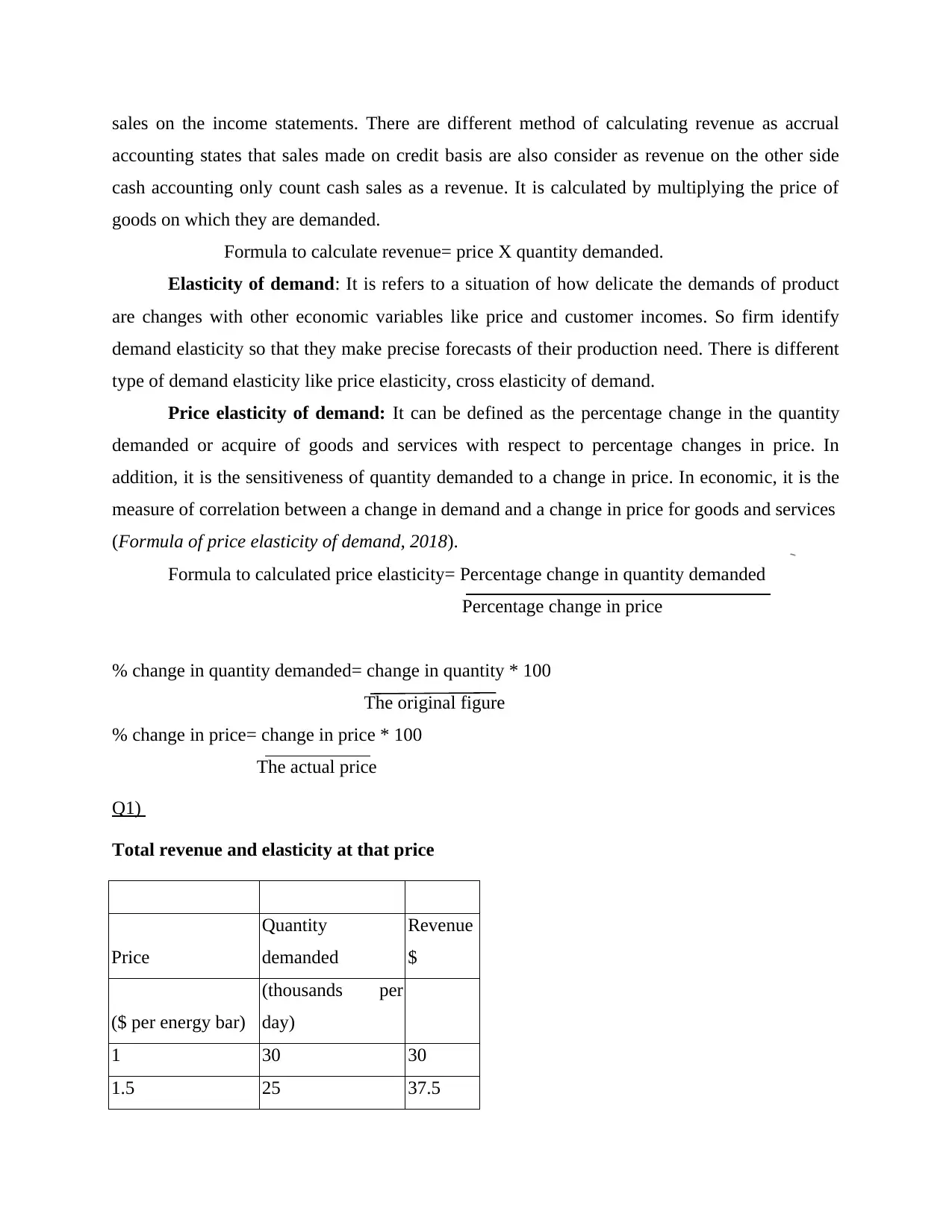
sales on the income statements. There are different method of calculating revenue as accrual
accounting states that sales made on credit basis are also consider as revenue on the other side
cash accounting only count cash sales as a revenue. It is calculated by multiplying the price of
goods on which they are demanded.
Formula to calculate revenue= price X quantity demanded.
Elasticity of demand: It is refers to a situation of how delicate the demands of product
are changes with other economic variables like price and customer incomes. So firm identify
demand elasticity so that they make precise forecasts of their production need. There is different
type of demand elasticity like price elasticity, cross elasticity of demand.
Price elasticity of demand: It can be defined as the percentage change in the quantity
demanded or acquire of goods and services with respect to percentage changes in price. In
addition, it is the sensitiveness of quantity demanded to a change in price. In economic, it is the
measure of correlation between a change in demand and a change in price for goods and services
(Formula of price elasticity of demand, 2018).
Formula to calculated price elasticity= Percentage change in quantity demanded
Percentage change in price
% change in quantity demanded= change in quantity * 100
The original figure
% change in price= change in price * 100
The actual price
Q1)
Total revenue and elasticity at that price
Price
Quantity
demanded
Revenue
$
($ per energy bar)
(thousands per
day)
1 30 30
1.5 25 37.5
accounting states that sales made on credit basis are also consider as revenue on the other side
cash accounting only count cash sales as a revenue. It is calculated by multiplying the price of
goods on which they are demanded.
Formula to calculate revenue= price X quantity demanded.
Elasticity of demand: It is refers to a situation of how delicate the demands of product
are changes with other economic variables like price and customer incomes. So firm identify
demand elasticity so that they make precise forecasts of their production need. There is different
type of demand elasticity like price elasticity, cross elasticity of demand.
Price elasticity of demand: It can be defined as the percentage change in the quantity
demanded or acquire of goods and services with respect to percentage changes in price. In
addition, it is the sensitiveness of quantity demanded to a change in price. In economic, it is the
measure of correlation between a change in demand and a change in price for goods and services
(Formula of price elasticity of demand, 2018).
Formula to calculated price elasticity= Percentage change in quantity demanded
Percentage change in price
% change in quantity demanded= change in quantity * 100
The original figure
% change in price= change in price * 100
The actual price
Q1)
Total revenue and elasticity at that price
Price
Quantity
demanded
Revenue
$
($ per energy bar)
(thousands per
day)
1 30 30
1.5 25 37.5
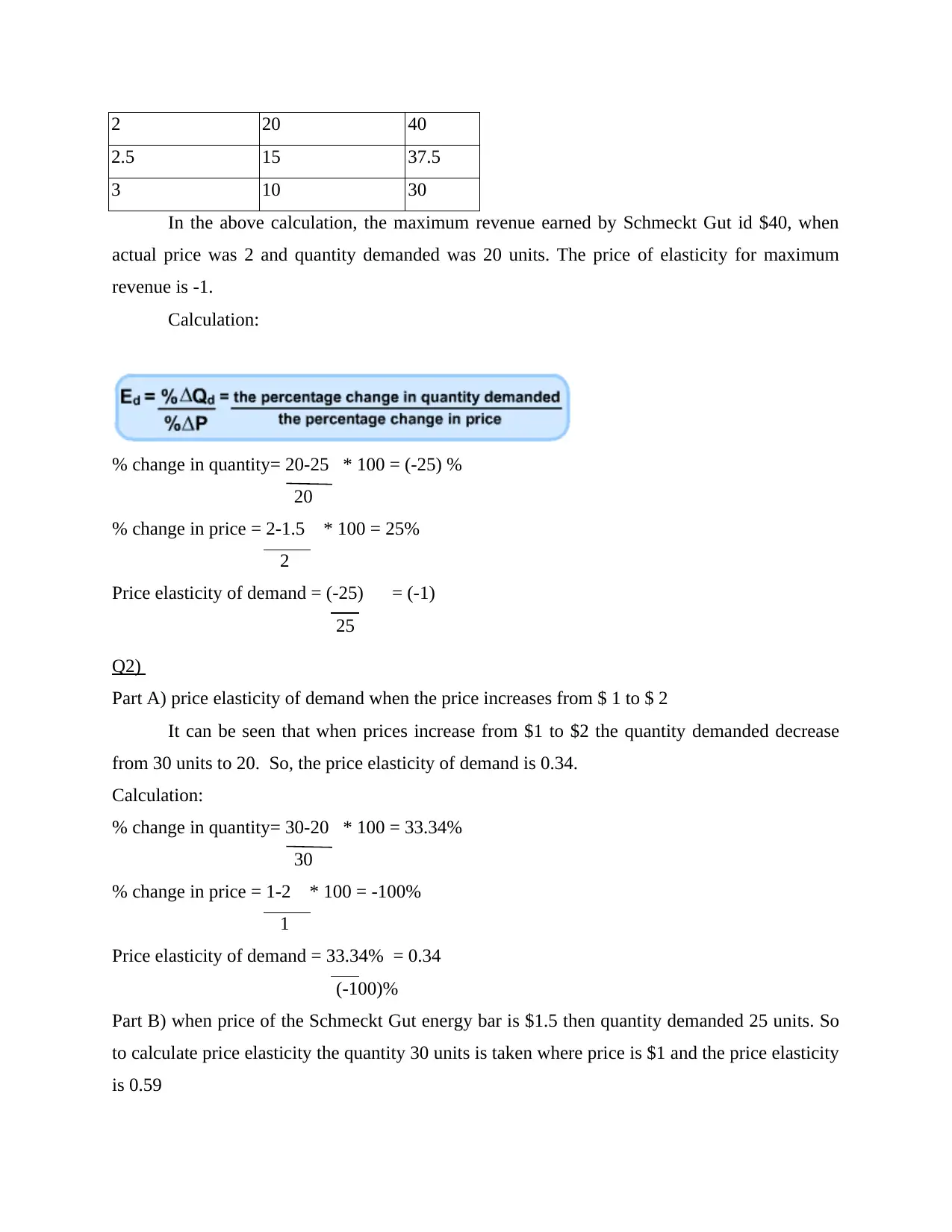
2 20 40
2.5 15 37.5
3 10 30
In the above calculation, the maximum revenue earned by Schmeckt Gut id $40, when
actual price was 2 and quantity demanded was 20 units. The price of elasticity for maximum
revenue is -1.
Calculation:
% change in quantity= 20-25 * 100 = (-25) %
20
% change in price = 2-1.5 * 100 = 25%
2
Price elasticity of demand = (-25) = (-1)
25
Q2)
Part A) price elasticity of demand when the price increases from $ 1 to $ 2
It can be seen that when prices increase from $1 to $2 the quantity demanded decrease
from 30 units to 20. So, the price elasticity of demand is 0.34.
Calculation:
% change in quantity= 30-20 * 100 = 33.34%
30
% change in price = 1-2 * 100 = -100%
1
Price elasticity of demand = 33.34% = 0.34
(-100)%
Part B) when price of the Schmeckt Gut energy bar is $1.5 then quantity demanded 25 units. So
to calculate price elasticity the quantity 30 units is taken where price is $1 and the price elasticity
is 0.59
2.5 15 37.5
3 10 30
In the above calculation, the maximum revenue earned by Schmeckt Gut id $40, when
actual price was 2 and quantity demanded was 20 units. The price of elasticity for maximum
revenue is -1.
Calculation:
% change in quantity= 20-25 * 100 = (-25) %
20
% change in price = 2-1.5 * 100 = 25%
2
Price elasticity of demand = (-25) = (-1)
25
Q2)
Part A) price elasticity of demand when the price increases from $ 1 to $ 2
It can be seen that when prices increase from $1 to $2 the quantity demanded decrease
from 30 units to 20. So, the price elasticity of demand is 0.34.
Calculation:
% change in quantity= 30-20 * 100 = 33.34%
30
% change in price = 1-2 * 100 = -100%
1
Price elasticity of demand = 33.34% = 0.34
(-100)%
Part B) when price of the Schmeckt Gut energy bar is $1.5 then quantity demanded 25 units. So
to calculate price elasticity the quantity 30 units is taken where price is $1 and the price elasticity
is 0.59
⊘ This is a preview!⊘
Do you want full access?
Subscribe today to unlock all pages.

Trusted by 1+ million students worldwide
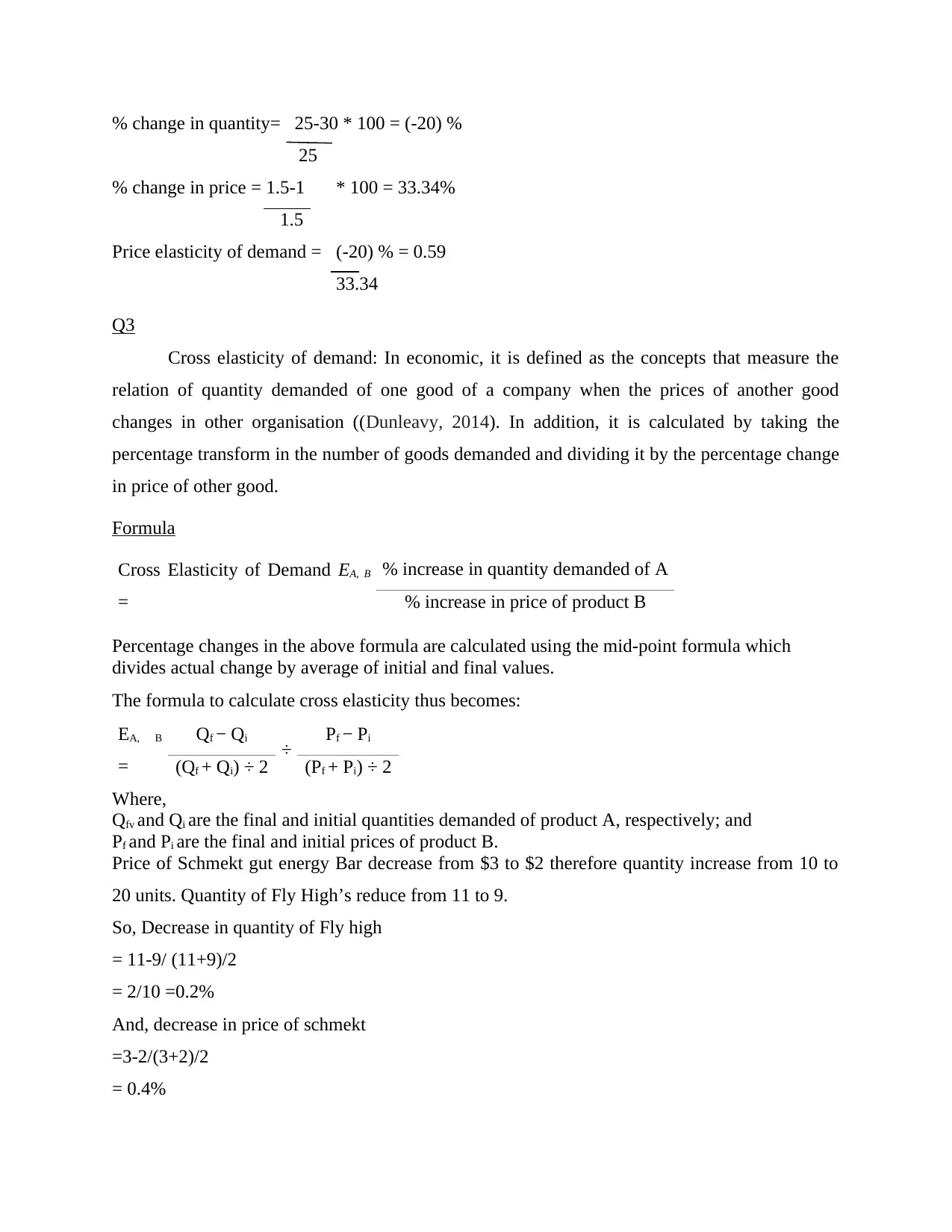
% change in quantity= 25-30 * 100 = (-20) %
25
% change in price = 1.5-1 * 100 = 33.34%
1.5
Price elasticity of demand = (-20) % = 0.59
33.34
Q3
Cross elasticity of demand: In economic, it is defined as the concepts that measure the
relation of quantity demanded of one good of a company when the prices of another good
changes in other organisation ((Dunleavy, 2014). In addition, it is calculated by taking the
percentage transform in the number of goods demanded and dividing it by the percentage change
in price of other good.
Formula
Cross Elasticity of Demand EA, B
=
% increase in quantity demanded of A
% increase in price of product B
Percentage changes in the above formula are calculated using the mid-point formula which
divides actual change by average of initial and final values.
The formula to calculate cross elasticity thus becomes:
EA, B
=
Qf − Qi
÷ Pf − Pi
(Qf + Qi) ÷ 2 (Pf + Pi) ÷ 2
Where,
Qfv and Qi are the final and initial quantities demanded of product A, respectively; and
Pf and Pi are the final and initial prices of product B.
Price of Schmekt gut energy Bar decrease from $3 to $2 therefore quantity increase from 10 to
20 units. Quantity of Fly High’s reduce from 11 to 9.
So, Decrease in quantity of Fly high
= 11-9/ (11+9)/2
= 2/10 =0.2%
And, decrease in price of schmekt
=3-2/(3+2)/2
= 0.4%
25
% change in price = 1.5-1 * 100 = 33.34%
1.5
Price elasticity of demand = (-20) % = 0.59
33.34
Q3
Cross elasticity of demand: In economic, it is defined as the concepts that measure the
relation of quantity demanded of one good of a company when the prices of another good
changes in other organisation ((Dunleavy, 2014). In addition, it is calculated by taking the
percentage transform in the number of goods demanded and dividing it by the percentage change
in price of other good.
Formula
Cross Elasticity of Demand EA, B
=
% increase in quantity demanded of A
% increase in price of product B
Percentage changes in the above formula are calculated using the mid-point formula which
divides actual change by average of initial and final values.
The formula to calculate cross elasticity thus becomes:
EA, B
=
Qf − Qi
÷ Pf − Pi
(Qf + Qi) ÷ 2 (Pf + Pi) ÷ 2
Where,
Qfv and Qi are the final and initial quantities demanded of product A, respectively; and
Pf and Pi are the final and initial prices of product B.
Price of Schmekt gut energy Bar decrease from $3 to $2 therefore quantity increase from 10 to
20 units. Quantity of Fly High’s reduce from 11 to 9.
So, Decrease in quantity of Fly high
= 11-9/ (11+9)/2
= 2/10 =0.2%
And, decrease in price of schmekt
=3-2/(3+2)/2
= 0.4%
Paraphrase This Document
Need a fresh take? Get an instant paraphrase of this document with our AI Paraphraser
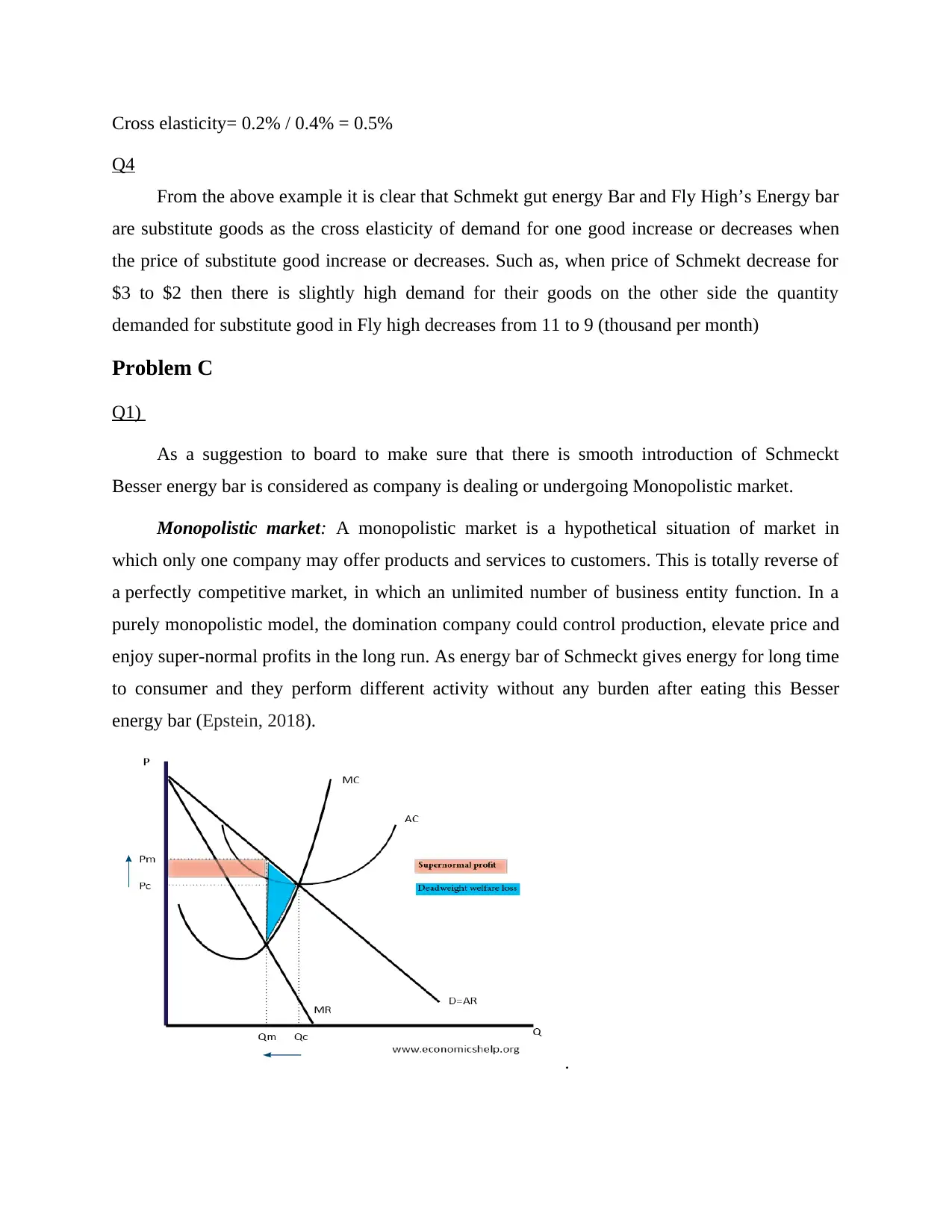
Cross elasticity= 0.2% / 0.4% = 0.5%
Q4
From the above example it is clear that Schmekt gut energy Bar and Fly High’s Energy bar
are substitute goods as the cross elasticity of demand for one good increase or decreases when
the price of substitute good increase or decreases. Such as, when price of Schmekt decrease for
$3 to $2 then there is slightly high demand for their goods on the other side the quantity
demanded for substitute good in Fly high decreases from 11 to 9 (thousand per month)
Problem C
Q1)
As a suggestion to board to make sure that there is smooth introduction of Schmeckt
Besser energy bar is considered as company is dealing or undergoing Monopolistic market.
Monopolistic market: A monopolistic market is a hypothetical situation of market in
which only one company may offer products and services to customers. This is totally reverse of
a perfectly competitive market, in which an unlimited number of business entity function. In a
purely monopolistic model, the domination company could control production, elevate price and
enjoy super-normal profits in the long run. As energy bar of Schmeckt gives energy for long time
to consumer and they perform different activity without any burden after eating this Besser
energy bar (Epstein, 2018).
.
Q4
From the above example it is clear that Schmekt gut energy Bar and Fly High’s Energy bar
are substitute goods as the cross elasticity of demand for one good increase or decreases when
the price of substitute good increase or decreases. Such as, when price of Schmekt decrease for
$3 to $2 then there is slightly high demand for their goods on the other side the quantity
demanded for substitute good in Fly high decreases from 11 to 9 (thousand per month)
Problem C
Q1)
As a suggestion to board to make sure that there is smooth introduction of Schmeckt
Besser energy bar is considered as company is dealing or undergoing Monopolistic market.
Monopolistic market: A monopolistic market is a hypothetical situation of market in
which only one company may offer products and services to customers. This is totally reverse of
a perfectly competitive market, in which an unlimited number of business entity function. In a
purely monopolistic model, the domination company could control production, elevate price and
enjoy super-normal profits in the long run. As energy bar of Schmeckt gives energy for long time
to consumer and they perform different activity without any burden after eating this Besser
energy bar (Epstein, 2018).
.
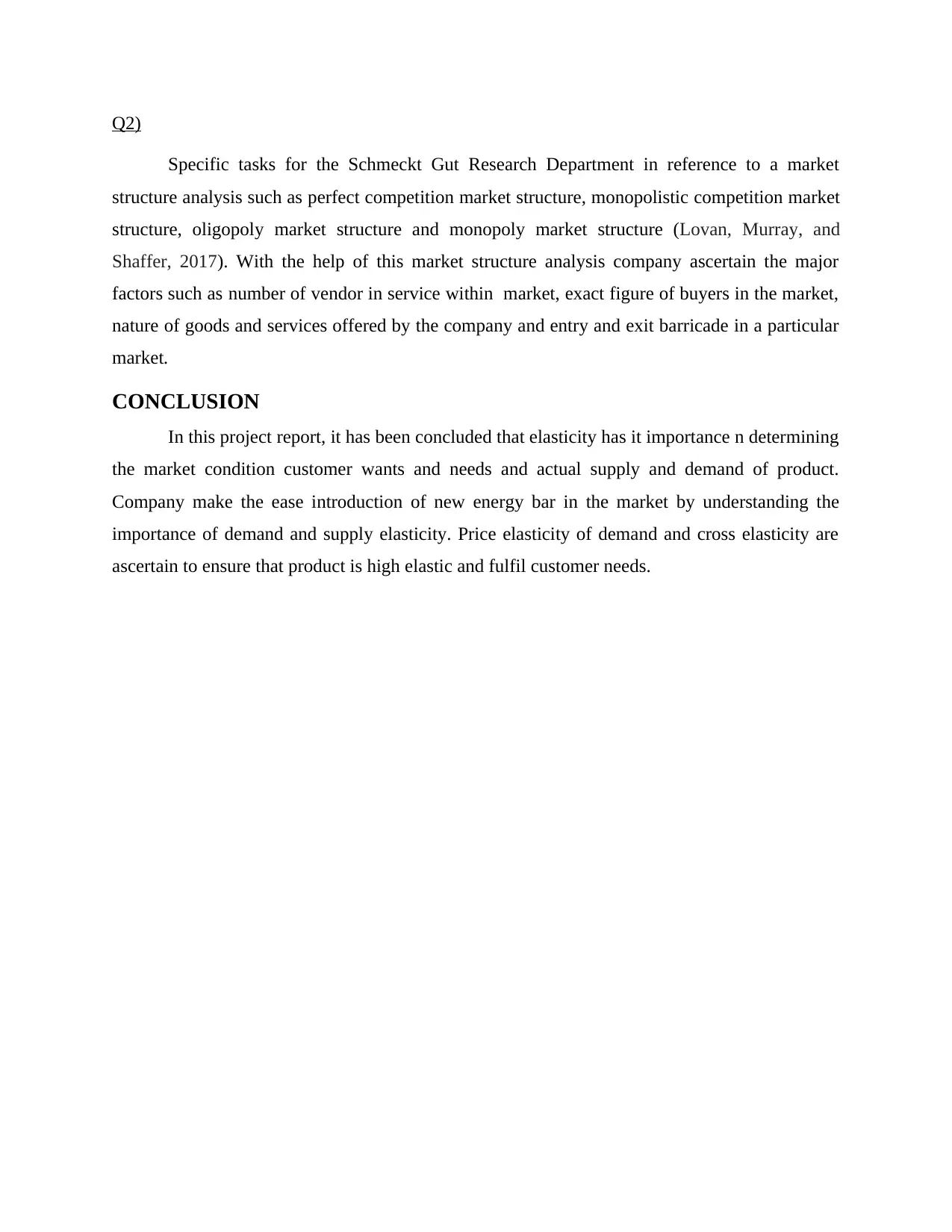
Q2)
Specific tasks for the Schmeckt Gut Research Department in reference to a market
structure analysis such as perfect competition market structure, monopolistic competition market
structure, oligopoly market structure and monopoly market structure (Lovan, Murray, and
Shaffer, 2017). With the help of this market structure analysis company ascertain the major
factors such as number of vendor in service within market, exact figure of buyers in the market,
nature of goods and services offered by the company and entry and exit barricade in a particular
market.
CONCLUSION
In this project report, it has been concluded that elasticity has it importance n determining
the market condition customer wants and needs and actual supply and demand of product.
Company make the ease introduction of new energy bar in the market by understanding the
importance of demand and supply elasticity. Price elasticity of demand and cross elasticity are
ascertain to ensure that product is high elastic and fulfil customer needs.
Specific tasks for the Schmeckt Gut Research Department in reference to a market
structure analysis such as perfect competition market structure, monopolistic competition market
structure, oligopoly market structure and monopoly market structure (Lovan, Murray, and
Shaffer, 2017). With the help of this market structure analysis company ascertain the major
factors such as number of vendor in service within market, exact figure of buyers in the market,
nature of goods and services offered by the company and entry and exit barricade in a particular
market.
CONCLUSION
In this project report, it has been concluded that elasticity has it importance n determining
the market condition customer wants and needs and actual supply and demand of product.
Company make the ease introduction of new energy bar in the market by understanding the
importance of demand and supply elasticity. Price elasticity of demand and cross elasticity are
ascertain to ensure that product is high elastic and fulfil customer needs.
⊘ This is a preview!⊘
Do you want full access?
Subscribe today to unlock all pages.

Trusted by 1+ million students worldwide
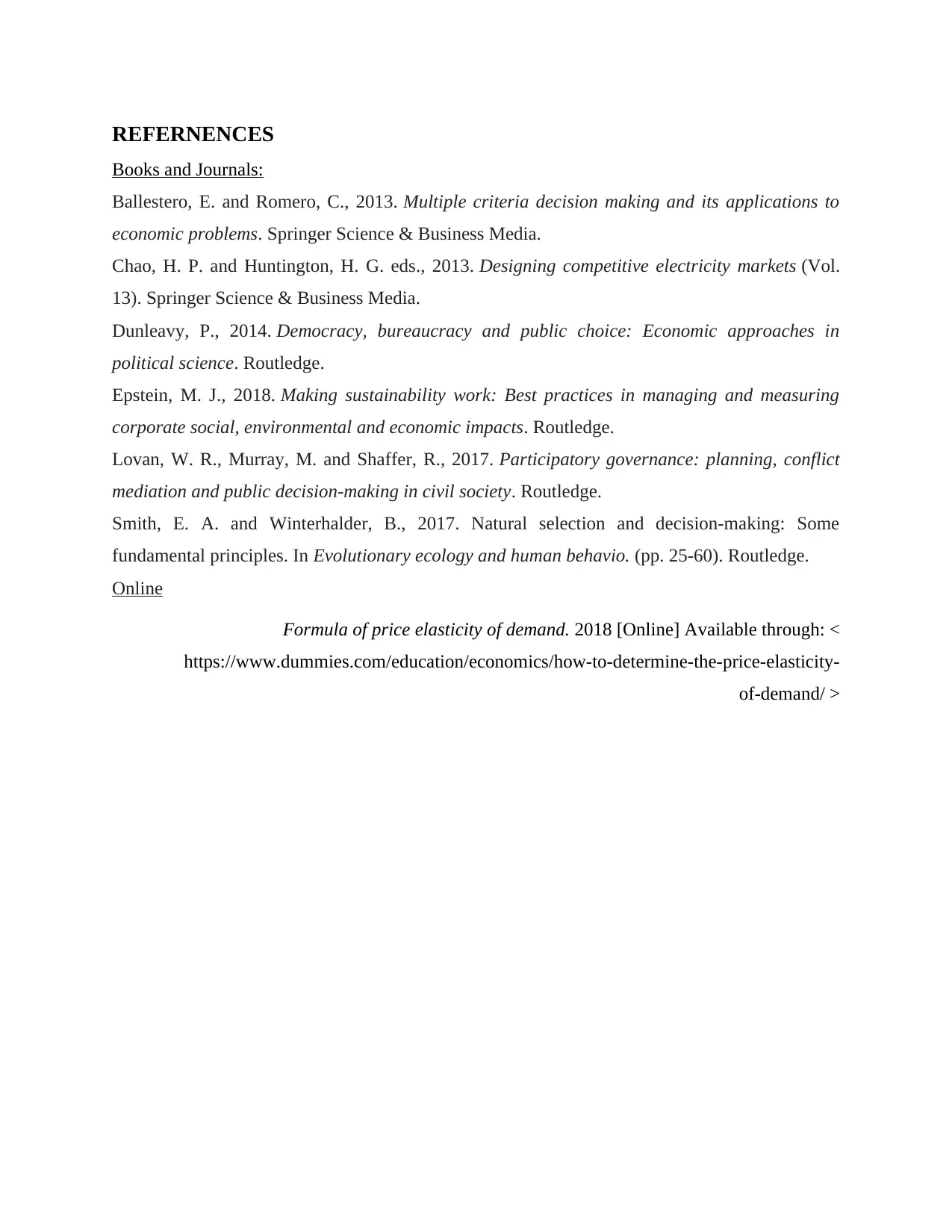
REFERNENCES
Books and Journals:
Ballestero, E. and Romero, C., 2013. Multiple criteria decision making and its applications to
economic problems. Springer Science & Business Media.
Chao, H. P. and Huntington, H. G. eds., 2013. Designing competitive electricity markets (Vol.
13). Springer Science & Business Media.
Dunleavy, P., 2014. Democracy, bureaucracy and public choice: Economic approaches in
political science. Routledge.
Epstein, M. J., 2018. Making sustainability work: Best practices in managing and measuring
corporate social, environmental and economic impacts. Routledge.
Lovan, W. R., Murray, M. and Shaffer, R., 2017. Participatory governance: planning, conflict
mediation and public decision-making in civil society. Routledge.
Smith, E. A. and Winterhalder, B., 2017. Natural selection and decision-making: Some
fundamental principles. In Evolutionary ecology and human behavio. (pp. 25-60). Routledge.
Online
Formula of price elasticity of demand. 2018 [Online] Available through: <
https://www.dummies.com/education/economics/how-to-determine-the-price-elasticity-
of-demand/ >
Books and Journals:
Ballestero, E. and Romero, C., 2013. Multiple criteria decision making and its applications to
economic problems. Springer Science & Business Media.
Chao, H. P. and Huntington, H. G. eds., 2013. Designing competitive electricity markets (Vol.
13). Springer Science & Business Media.
Dunleavy, P., 2014. Democracy, bureaucracy and public choice: Economic approaches in
political science. Routledge.
Epstein, M. J., 2018. Making sustainability work: Best practices in managing and measuring
corporate social, environmental and economic impacts. Routledge.
Lovan, W. R., Murray, M. and Shaffer, R., 2017. Participatory governance: planning, conflict
mediation and public decision-making in civil society. Routledge.
Smith, E. A. and Winterhalder, B., 2017. Natural selection and decision-making: Some
fundamental principles. In Evolutionary ecology and human behavio. (pp. 25-60). Routledge.
Online
Formula of price elasticity of demand. 2018 [Online] Available through: <
https://www.dummies.com/education/economics/how-to-determine-the-price-elasticity-
of-demand/ >
Paraphrase This Document
Need a fresh take? Get an instant paraphrase of this document with our AI Paraphraser


1
⊘ This is a preview!⊘
Do you want full access?
Subscribe today to unlock all pages.

Trusted by 1+ million students worldwide
1 out of 12
Related Documents
Your All-in-One AI-Powered Toolkit for Academic Success.
+13062052269
info@desklib.com
Available 24*7 on WhatsApp / Email
![[object Object]](/_next/static/media/star-bottom.7253800d.svg)
Unlock your academic potential
Copyright © 2020–2025 A2Z Services. All Rights Reserved. Developed and managed by ZUCOL.





